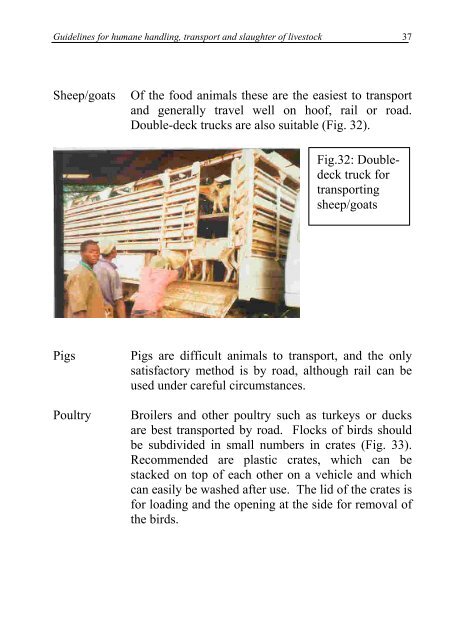Guidelines for humane handling, transport and slaughter of
Guidelines for humane handling, transport and slaughter of
Guidelines for humane handling, transport and slaughter of
Create successful ePaper yourself
Turn your PDF publications into a flip-book with our unique Google optimized e-Paper software.
<strong>Guidelines</strong> <strong>for</strong> <strong>humane</strong> <strong>h<strong>and</strong>ling</strong>, <strong>transport</strong> <strong>and</strong> <strong>slaughter</strong> <strong>of</strong> livestock 37<br />
Sheep/goats<br />
Of the food animals these are the easiest to <strong>transport</strong><br />
<strong>and</strong> generally travel well on ho<strong>of</strong>, rail or road.<br />
Double-deck trucks are also suitable (Fig. 32).<br />
Fig.32: Doubledeck<br />
truck <strong>for</strong><br />
<strong>transport</strong>ing<br />
sheep/goats<br />
Pigs<br />
Poultry<br />
Pigs are difficult animals to <strong>transport</strong>, <strong>and</strong> the only<br />
satisfactory method is by road, although rail can be<br />
used under careful circumstances.<br />
Broilers <strong>and</strong> other poultry such as turkeys or ducks<br />
are best <strong>transport</strong>ed by road. Flocks <strong>of</strong> birds should<br />
be subdivided in small numbers in crates (Fig. 33).<br />
Recommended are plastic crates, which can be<br />
stacked on top <strong>of</strong> each other on a vehicle <strong>and</strong> which<br />
can easily be washed after use. The lid <strong>of</strong> the crates is<br />
<strong>for</strong> loading <strong>and</strong> the opening at the side <strong>for</strong> removal <strong>of</strong><br />
the birds.
















